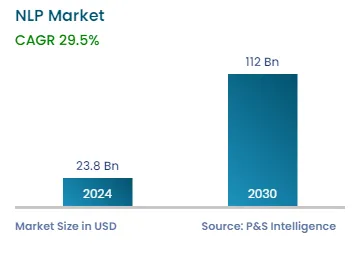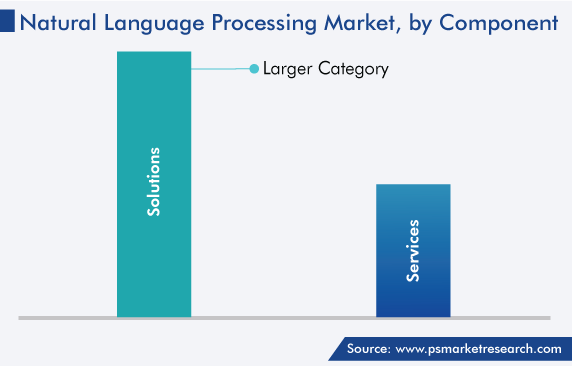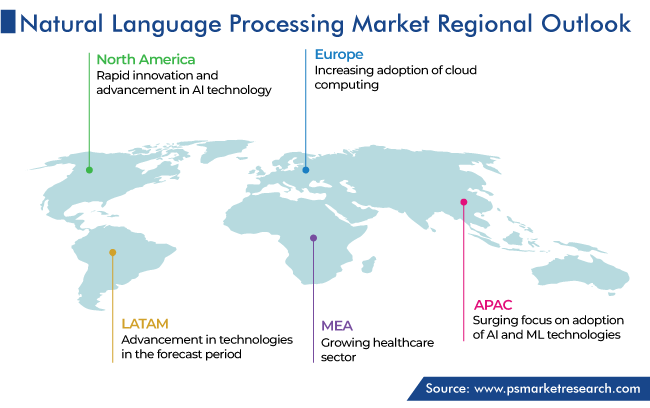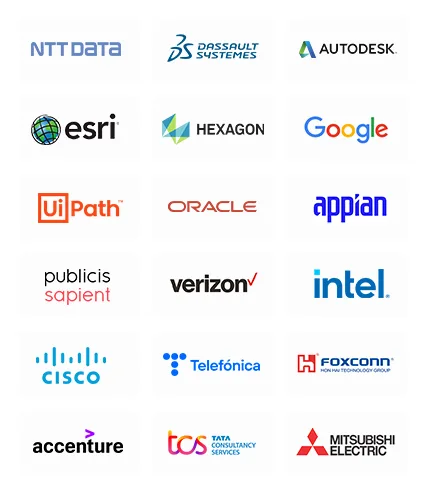Market Statistics
| Study Period | 2019 - 2030 |
| 2024 Market Size | USD 23.8 Billion |
| 2030 Forecast | USD 112 Billion |
| Growth Rate(CAGR) | 29.5% |
| Largest Region | North America |
| Fastest Growing Region | Asia-Pacific |
| Nature of the Market | Fragmented |
Report Code: 11791
Get a Comprehensive Overview of the Natural Language Processing Market Report Prepared by P&S Intelligence, Segmented by Type (Statistical, Rule-Based, Hybrid), Deployment (Cloud, On-Premises), Component (Solutions, Services), Application (Information Extraction, Question Answering, Machine Translation, Report Generation, Text Processing), Industry (BFSI, Automotive, Healthcare, Retail, IT and Telecommunications), Technology (Interactive Voice Response, Optical Character Recognition, Text Analytics, Speech Analytics, Classification and Categorization, Image Recognition), Organization Size (Large Enterprises, SMEs), and Geographic Regions. This Report Provides Insights From 2019 to 2030.
| Study Period | 2019 - 2030 |
| 2024 Market Size | USD 23.8 Billion |
| 2030 Forecast | USD 112 Billion |
| Growth Rate(CAGR) | 29.5% |
| Largest Region | North America |
| Fastest Growing Region | Asia-Pacific |
| Nature of the Market | Fragmented |

Explore the market potential with our data-driven report
The natural language processing (NLP) market size stood at USD 23.8 billion in 2024, and it is expected to reach USD 112.0 billion by 2030, exhibiting a CAGR of 29.5% during 2024–2030. The growth of the market can be ascribed to the increasing use of chatbots for assisting customer services. In addition, other factors such as developments in text-analyzing computer programs, increasing investment across the healthcare sector, and growing demand for enterprise solutions to streamline business operations for better customer experience are expected to drive the adoption of NLP.
Moreover, enterprises have already started to adopt cloud-based solutions to provide better stability and reduce the overall time required for data collection and processing. Thus, AI-powered chatbots and cloud-based voice recognizer systems aid in most of the business operations and help in making data-driven decisions. The data collected with the help of chatbots is further used to analyze the demand for a particular product.
Technological advancement in AI has also transformed the way by which a business operates. Many companies, mainly start-ups and small and medium enterprises, are using AI-enabled technology with customized solutions according to their requirements.
Furthermore, the market is experiencing a rise due to the surging need for intelligent gadgets and the increasing demand for advanced text analytics. Therefore, challenges arise from the intricate use of language that blends code when implementing NLP solutions. On the other hand, the market is expected to grow from the increased automation brought about by the integration of NLP with deep learning and ML.
For instance, Amazon is playing a significant role in artificial intelligence with the help of its virtual voice assistant, named Alexa. Amazon also embedded AI across various aspects of its business operations, such as one most effective Amazon concepts of predictive shipping in which it collects a lot of data about customer preferences and buying habits, and has a tremendous amount of confidence in its data-driven capabilities, which allows it not only to recommend products but also in predicting human needs.
Additionally, in today’s era, Amazon has also introduced a groundbreaking convenience store concept known as Amazon GO, unlike the traditional checkouts Amazon GO outlets, that eliminates the need for traditional checkouts. It has installed AI cameras as well as employed cutting-edge AI technology that monitors customers’ selected items and automatically charges them through the Amazon GO app on their smartphones. It is a checkout-free shopping system.
Enormous Rise in Healthcare Sector Drives the Market
The healthcare industry holds the largest market share, as it is currently experiencing a hike in data generation due to the increased digitalization in hospitals and healthcare facilities. The healthcare sector finds it difficult to operate without sophisticated systems, as it is challenging to analyze the text data and is eager to leverage analytics to gain meaningful insights. Thus, natural language processing (NLP) has emerged as a crucial technology to extract valuable insight from this large volume of textual healthcare data. As a result, there is a growing demand for sophisticated data management and advanced data analytics solutions within the healthcare sector.
Moreover, personal health records (PHRs) have become widely accepted, and therefore new initiatives have been taken to make it easier to download and share medical records with different medical departments. Thus, NLP in healthcare has enabled predictive analysis and helped minimize population health concerns. Also, the adoption of NLP is rising in this field, due to the recognized potential to search, analyze, and interpret massive amounts of potential datasets.
Based on type, the rule-based category is expected to witness significant growth in the coming years. This can be because rule-based NLP places a strong emphasis on pattern matching, a crucial skill in the healthcare industry. The technique proves valuable in healthcare by improving the electronic health record (EHR) process through the identification of specific phrases, thereby enhancing data management efficiency.
Also, the hybrid category holds a significant share. This is because the hybrid approach represents a fusion of strengths of rule-based and machine-learning NLP methods, incorporating NLP, ML, and human inputs. With the help of human expertise, it guides accurate analysis, while ML simplifies the scalability of this analysis. By combining rule-based and statistical NLP technologies in a hybrid manner, organizations can harness the benefits and approaches of both. When implementing the hybrid NLP approach, there are various options available to select the most suitable path for managing data and expediting business decisions.
Based on deployment, the cloud category held the largest share, of 65%, in 2023, and it is expected to grow at the highest CAGR during the forecast period. This is due to the rising adoption of cloud-based software and services.
The public cloud deployment holds a significant market share, as it offers full control, visibility, and authentication security controls over data. In addition, the hybrid category is expected to witness significant growth in the coming years. This can be because hybrid cloud deployment combines the benefits of both public and private cloud deployment models, enjoys the benefits of both, and supports AI-based tools and technology adoption.
Based on component, the solution category is expected to maintain its dominance in the future, due to its capabilities, such as ensuring businesses enhance financial processes, boosting operational efficiency, and reducing operational costs. Further, engines, tools, interfaces, and platforms that make up an NLG program process translate computer code into language.
On the other hand, the service category is projected to witness a higher growth rate in the coming years, as it allows organizations to integrate artificial intelligence-driven NLP services for building AI chatbots, entity recognition, extracting data from PDF, intent classification, and text categorization. Moreover, this is due to the rapid implementation of software, it helps in reducing the development expenses and risk, and the optimization of existing installations.
In addition, the service sector encompasses a variety of services tailored for businesses utilizing natural language generation tools. Thus, the demand for these services is rising, as the adoption of NLP generation software expands across various industries. Also, these services play a crucial role in enabling businesses to effectively implement and harness the full potential of natural language generation tools.

The report generation category holds the largest market share, accounting for 35% of the total revenue in 2023. This is attributed to the role of NLP in helping compliance teams in their analysis of critical information within structured data and in uncovering abnormal and hidden patterns within extensive datasets. Also, NLP tools are increasingly finding applications in risk and threat detection activities.
The process of text summarizing involves developing algorithms or software that can condense textual data and generate concise summaries. The primary challenge in text summarization is to distill the essence of a document into fewer sentences and words. Methods for extracting information from unstructured text data and utilizing it for summarization purposes can broadly be categorized into two approaches: extractive and abstractive methods.
Drive strategic growth with comprehensive market analysis
North America holds the largest revenue share in the market for NLP, and it is expected to witness the same trend in the coming years. This dominance can be due to several factors such as rapid innovation and advancement in AI technology and the presence of major market players in the region.
Additionally, leading companies, such as Google, IBM, Microsoft, and Meta, have been instrumental in introducing various innovations in NLP Technology. These innovations have led to enhancement in precision, speed, and problem-solving methods, making NLP an increasingly value tool for computer scientists and professionals dealing with complex challenges.
Furthermore, the European market is projected to witness a high growth rate during the forecast period. This can be due to the increasing adoption of cloud computing among enterprises in the region.

Whereas, the APAC market is projected to record the highest CAGR in the coming years. This can be ascribed to the surging focus on the adoption of AI and ML technologies, the increasing usage of smartphones, the rapid advancement in the technology sector, the digitalization of economies, and government initiatives. Also, the region holds a leading position in cutting-edge technology and industries like robotics, which in basic has a strong infrastructure, information technology, software, and service offerings.
This report offers deep insights into the natural language processing industry, with size estimation for 2019 to 2030, the major drivers, restraints, trends and opportunities, and competitor analysis.
Based on Type
Based on Deployment
Based on Component
Based on Application
Based on Industry
Based on Technology
Based on Organization Size
Geographical Analysis
The NLP market size stood at USD 23.8 billion in 2024.
During 2024–2030, the growth rate of the NLP market will be around 29.5%.
Report generation is the largest type in the NLP market.
The major drivers of the NLP market include the increasing use of chatbots for assisting customer services and AI-powered chatbots and cloud-based voice-recognizing systems aid in most business operations and help in making data-driven decisions.
Want a report tailored exactly to your business need?
Request CustomizationLeading companies across industries trust us to deliver data-driven insights and innovative solutions for their most critical decisions. From data-driven strategies to actionable insights, we empower the decision-makers who shape industries and define the future. From Fortune 500 companies to innovative startups, we are proud to partner with organisations that drive progress in their industries.


Working with P&S Intelligence and their team was an absolute pleasure – their awareness of timelines and commitment to value greatly contributed to our project's success. Eagerly anticipating future collaborations.
McKinsey & Company
IndiaOur insights into the minutest levels of the markets, including the latest trends and competitive landscape, give you all the answers you need to take your business to new heights
We take a cautious approach to protecting your personal and confidential information. Trust is the strongest bond that connects us and our clients, and trust we build by complying with all international and domestic data protection and privacy laws
Customize the Report to Align with Your Business Objectives
Request the Free Sample Pages